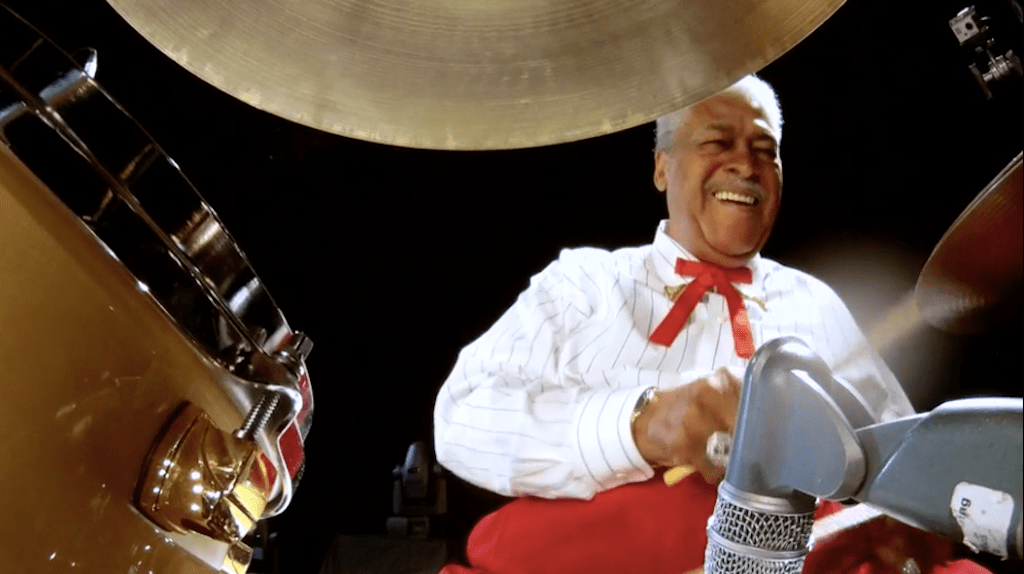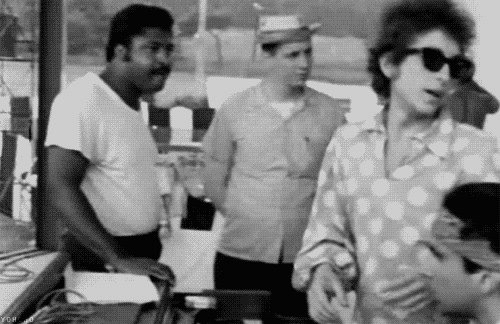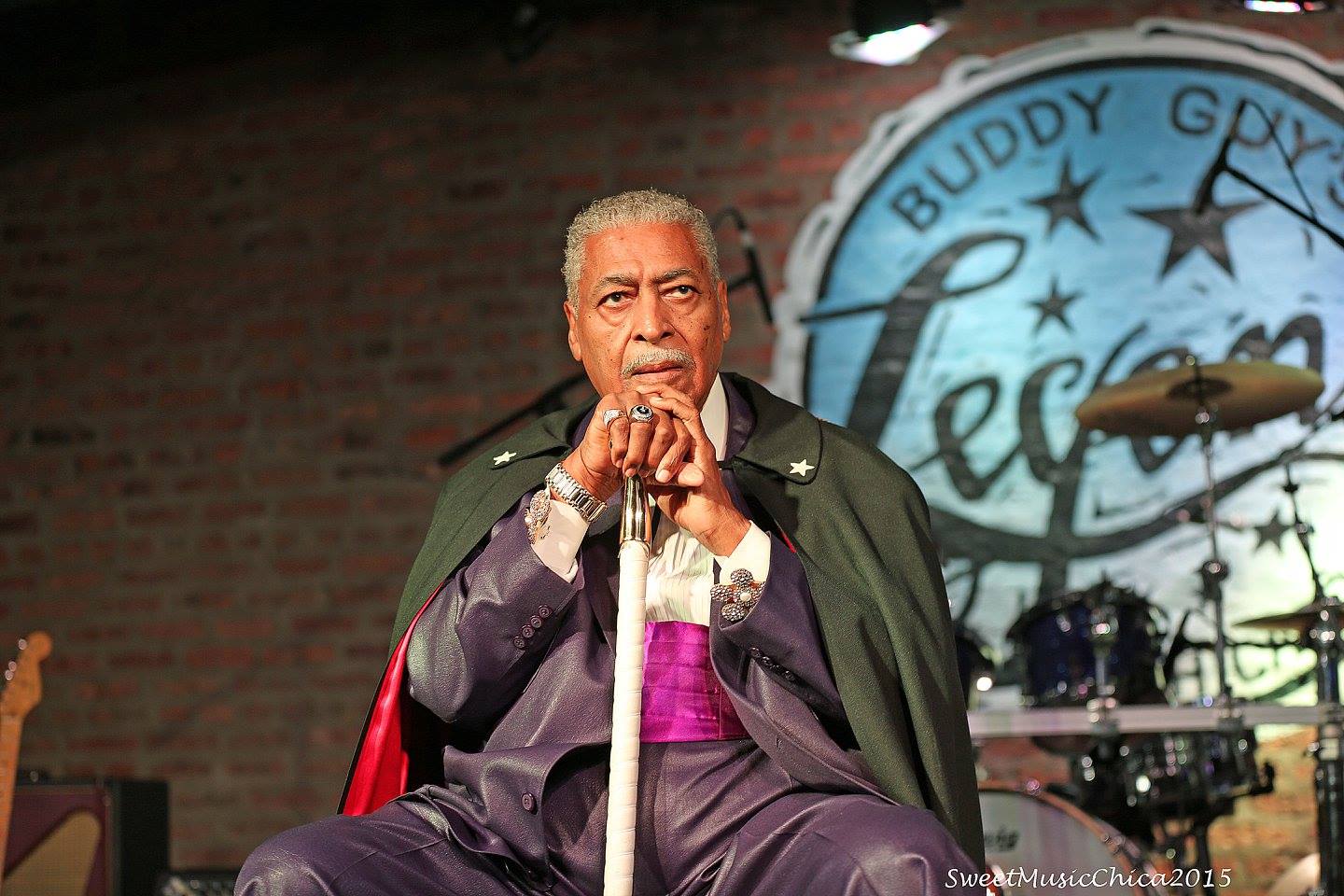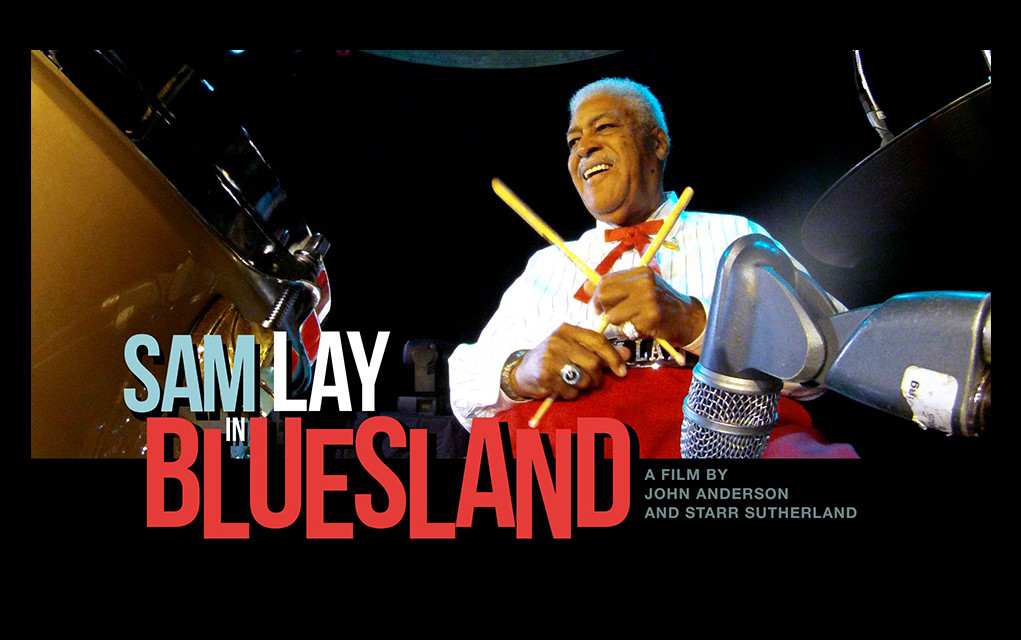Ever listen to any given volume of Chess records — Howlin’ Wolf, Muddy Waters, Willie Dixon, Lightnin’ Hopkins — or Bob Dylan’s Highway 61? Then you’ve heard drummer Sam Lay. He was the prominent pulse on classic tracks you’ve listened to countless times over. You’ve heard his cowbell, penny-whistle, and double-shuffle as only he can deliver it — a beat Iggy Pop learned from Sam himself. When Dylan went electric at the Newport Folk Festival in 1965, it was Sam who backed him up on drums. A founding member of the Paul Butterfield Blues Band, he earned a place in the Rock and Roll Hall of Fame in 2015.
If there is a human equivalent of the evolution of the blues, it is Sam Lay. Grammy-nominated director John Anderson understands this and has distilled his insights into yet another artful film: Sam Lay in Bluesland. Other artists John has worked with include Brian Wilson, Pete Townshend, Neil Young, Ray Davies, Paul McCartney, Patti Smith, John Fogerty, Elvis Costello, Jack White, John Prine, Badfinger, James Cotton, Kris Kristofferson, Steve Miller, Bonnie Raitt, Jackson Browne, Eric Clapton, Emmylou Harris, and many more.
I sat down with both of them to discuss Sam’s prolific career, John’s fascinating experiences in filmmaking, and the details surrounding the documentary.

Lauren for ABS:
Sam Lay’s story originates in Birmingham, Alabama. Is that correct?
Sam Lay: Ok. Yes.
John Anderson: Yeah, he was born and raised there. And then he eventually made it to Cleveland. Right, Sam? You were about 18?
Sam: You’re about right. If not, you’re close to it.
John: And that’s where you ran into that blues band. What was his name? Tommy? What was it, Sam?
Sam: That was in Cleveland. Tom O’ Neill was in Cleveland.
John: That’s right, and that’s where you first started playing the drums, right?
Sam: No. I originally came from a jazz group called the Moon Dog Combo. It was the three of us. That’s where I originally started playing, which mostly we played jazz. That’s the first time I sat down with a set of drums was with Moon Dog. They called him Moon Dog. That wasn’t his name; that’s all we knew him by was Moon Dog. The guitar, the drums, and the piano. A fellow named Curly Beck used to play the piano for us.
John: And then you ran into Tommy O’Neill.
Sam: Oh, yeah. I ran into Tommy O’Neill kind of after then. And then there was a group that I named The Thunderbirds. I don’t know why I couldn’t think of a name for the band. So, I named that group The Thunderbirds. And I had it printed on my drum head.
Lauren: Talk about your journey to Chicago.
Sam: There’s so much to tell. I don’t know where to start.
John: Well, part of the reason, Sam, was to follow Liz. Right? Because Liz had come back to Chicago.
Sam: That was from Cleveland to here. I followed Liz out of Cleveland. And we’re still together. She’s sitting right here now.
Lauren: Can you describe early ’60s Chicago?
Sam: Well, there was a band in every little wine and beer joint. There was one door to door from each other. There were so many of them. You just walked in and picked your choice, whoever you liked to play with. To me, everywhere I stood in they liked me. If this band offered me ten dollars, another one would offer me eleven dollars. So I took the one dollar more. That’s where I managed to, you know, go place to place.
Lauren: I understand you played on 40 Chess recordings?
Sam: Perhaps more than that. If I went somewhere I’d jam with them. Everybody I played with wanted me in their band. They would get rid of their drummer, and I always took that dollar more.
Lauren: You were able to play with some of your idols around that time, such as Little Walter.
Sam: Oh, yeah. Actually, I came to Chicago mostly — other than my wife — to follow Little Walter here. My wife was here, and I came and visited and I just connected with Little Walter here. He heard me play and he hired me.
John: And he not only hired you; he took you and Liz in. Didn’t he?
Sam: I was just fixin’ to say that. So, we stayed. He didn’t charge us no rent.
Lauren: So, you all were pretty close.
Sam: You’re right. We were pretty close. My first kid was born when I was living with Walter.
John: Then you had the good luck of crossing paths with Wolf.
Lauren: Actually, that was my next question. The next chapter of your life would bring you to Howlin’ Wolf. I’m curious as to how both of you found each other.
Sam: His drummer had gotten hurt, if I’m not mistaken. He stepped on a board or something that had a nail sticking out of it, and he was unable to play. It was on a Wednesday night at a joint called The Playhouse; I do remember that. He got in touch with me and said that Howlin’ Wolf needed a drummer for that Wednesday night at a joint called The Playhouse, which is no longer there now. It’s a high-rise apartment building on 43rd. I played that night. And that one night, again, somebody heard me play and wanted me with their band. Anyway, the one Wednesday night lasted for seven years. I know it was at least seven years I was with him.
Lauren: A teenage Iggy Pop once showed up at your doorstep…
Sam: I was living in an apartment building. The doorbell rang one night; I had never seen him or heard of him, but I knew some people in Ann Arbor that knew him. I didn’t know them at the time either. Somebody gave him my address. He came and rang the bell, and I was like, “Hey, who is it?” He said his name was Iggy. I thought it was someone trying to be funny. I went downstairs and let him in. I only had one bedroom and a kitchen, you know? He told me who he was and what he was doing. It sounded like someone told him when he got to Chicago, if he could find me and that I might have somewhere he could stay for a night. That’s the way he put it.
He was just a little kid! In the neighborhood I was staying, him being that color, I kind of thought he didn’t have no business being there. But he trusted me.
Lauren: You played the role of mentor the way Howlin’ Wolf or Little Walter did with you when you were around that age.
Sam: He seemed so innocent. In other words, I still believe he was a child. I said, “Come on in. I only got one room here, me and my wife and my baby.” They were sleeping on the couch, my wife was. He was just a little kid. I didn’t know what to think, but I let him in. He was a nice kid. And even after I knew him for a while, he was just as nice as he was the day I met him.
Lauren: Even Iggy was a nice kid.
Sam: Oh, yeah. There was no doubt about it. No doubt about it. He wasn’t there long. But as long as I knew him, we got along perfect.
Lauren: Just to name a few, you’ve also played alongside Muddy Waters, Bo Diddley, Willie Dixon, John Lee Hooker, etc. You took the stage with Bob Dylan to play at the Newport Folk Festival.

Sam: Lightin’ Hopkins and… You name ‘em. I forgot more people than I can remember. They were all big names. Well, they were big names to us. James Cotton… I could go on and on and I still couldn’t remember them all.
Lauren: You played a couple of tracks on the notorious Highway 61 album.
Sam: Yeah, with Bob Dylan.
Lauren: What felt like the biggest career breakthrough for you?
Sam: Fathers & Sons helped quite a bit with Muddy Waters, and Otis Spann and all them guys together. I would go as far as to say that 61 with Dylan kind of put me on the map there a little bit. I’ve always thought a lot of him. Bob Dylan is my number one buddy. In my opinion, he’s one of the nicest people you’ll ever meet.
Lauren: John, for all the aforementioned reasons, Sam is basically a living, breathing, walking history of the blues. I’m so glad you’re involved in the making of this documentary. How did you first discover Sam?
Sam: Excuse me, but I am too.
Lauren: Good! John, did you grow up exposed to his music?
John: Yeah, though I was a little young for Newport. But I became aware of Sam shortly after that, really when the first and second Butterfield bands came out in ‘65 and ‘66. That was when I first started paying attention to the blues, and I noticed this incredible shuffling, revolving, alive backbeat.
I mean, I just never heard a drummer bring music to life like that before. And I was just fascinated by it on a musical level, you know, never thinking that I would — 30 years, 20 years later — move to Chicago and have the opportunity to meet and work with Sam. But it was really his work with Butterfield that got me excited.
Lauren: You’re talking about the signature double shuffle, right?
John: That’s right.
Sam: I’ve changed it to a triple.
John: Oh yeah? The legend grows.

Lauren: When did you first start production of Sam Lay in Bluesland?
John: Think we started around the middle of 2013. I had just finished a film called Born in Chicago that Sam was a part of, which was about the whole bunch of Chicago white kids like Barry Goldberg, Corky Siegel, Harvey Mandel, Michael Bloomfield, and Charlie Musselwhite and others who had learned the blues at the feet of the original masters on the South Side and brought it out to rock and roll. That was how I first got to know Sam was through the making of that film and filming him in concert. That was our first personal connection and how our friendship began.
Lauren: Does this film recount his 60+ year career up to present?
John: It does. He’s still doing gigs and still has that style. As someone says in the film, “With Sam, you don’t just get the music. You get Sam Lay.” You get a person who’s got a sense of style, a sense of dignity, a sense of class, and just an incredible rocking, bluesing beat. It’s hard to take your ears off of him. And when you’re watching him play, it’s hard to take your eyes off of him.
You know a Sam Lay track when you hear it, man. You can tell which ones Sam’s on. The cowbell on “Killing Floor” … I mean, there’s just some unique production ideas that Sam just invented.
Sam: I used the cowbell on “Shake It Baby,” too.
Lauren: Some of my favorite songs have cowbell.
John: “Mississippi Queen”!
Lauren: John, what’s it like working with Sam?
John: It’s amazing. You know, you never quite know what you’re gonna get. For all the interviews that we’ve done, he’s always got a new story for me. Through him, I’ve met so many people. Because of course, when we were making this film and we would contact everyone — Iggy included — they would say yes before you got through with the ask. They would just say, “What time do I need to show up?”
So, it’s meant so much to me just in terms of my knowledge as a filmmaker and the vast, different types of styles and people that I’ve met. Sam has introduced me to a whole lot, and I’m so thankful to him for that.
Lauren: I cannot wait to see it. Are you excited about the screening at the Chicago Blues Festival?
John: Yeah! It should be a wonderful event. It’s kicking off the Chicago Blues Festival that Sam often plays at. He’s not performing at it this year, but it would be great to get all of the Chicago blues people to once again pay respects to Sam.
Lauren: You have quite the filmography. Where can I and others find some of your films to watch at home?
John: The rock and roll ones you can generally find online or in stores — with Brian Wilson and John Prine and others. The blues ones I can send you links to; they’re all in various stages of being released, the three blues films which would be Born in Chicago and Sam Lay in Bluesland. And I’ve just finished a new film called Horn from the Heart: The Paul Butterfield Story.
Lauren: The Brian Wilson one and the John Prine one. Those are right up my alley.
John: I’ve got a relationship with Brian that goes back about 20 years. The films are out there; started with a film called Imagination. And then we did Brian Wilson on Tour, then Pet Sounds Live in London. We did SMiLE Live. In 2011 or 2012 I worked with him and The Beach Boys on a DVD called Doin’ It Again about the reunion that The Beach Boys had.
Lauren: I went to one of those shows!
John: Is that right? Where was that?
Lauren: It was at The Straz in Tampa, Florida. My friend got us backstage passes. He ended up with an extra one and invited me. I was happy to get my Spirit of America vinyl signed by all members except Brian. He got away before I could get him to sign, but he was nice to me.
John: Yeah. He’s like Sam: unbelievably strong. And here he is out on the road all year, again. Next month he’ll be 75. Of course, he’s got nothing on you, Sam. You’re 82!
Sam: Well, it’s ok to cheat a little bit.
Lauren: Complete and utter legends.
Sam: I just turned 82.
Lauren: You’ve been inducted into four different halls of fame, including The Rock and Roll Hall of Fame.
Sam: I’m like Jimmy Durante. I got a million of ‘em. I was inducted with Butterfield at The Rock and Roll Hall of Fame in 2015. I sleep with that trophy; I sleep with it on my pillow.
Lauren: I would, too. Yeah, congratulations! To both of you.
Sam: Thank you. Thank you very much. It’s just been great. The people around me looking out for me — all the people I’ve worked with I’ve enjoyed working with. Like I said, I always went where there was a dollar more. I think I stayed with Wolf longer than anybody. And I’ve been with Corky Siegel for 100 years already.
Lauren: I just want to let you know it’s been an honor talking to both of you. Thank you so much for your time.
Sam: Thank you.
John: Thank you for your interest, Lauren. We really appreciate it.
Sam: John? Hello?
Lauren: Sam, I think he is off the line now.
Sam: Oh, ok. Will I see you at one of these things they got coming up? Will you be at any of them?
Lauren: At the screening?
Sam: Yeah.
Lauren: Did you know that I live in Florida?
Sam: I was there a couple years ago. They brought me there and put a band around me, some local musicians. It was in Tallahassee. I liked the raw boiled peanuts.
Lauren: Always the best. And the farther you get into the country, the better they taste.
Sam: I think about them all the time. I can’t chew ‘em, but I can smell ‘em good. I got teeth. They don’t belong to me, but I got ‘em.
Lauren: They belong to you.
Sam: Oh, ok. Paid for in full.
Lauren: To answer your question, I won’t be at the screening. But I wish I could be. I haven’t planned it yet, but I want to visit Chicago.
Sam: I’ll tell you like Bob Barker, “Come on down!”
Lauren: I will visit you, of course!
Sam: Please do. I’d like to show you some of the photos I got, too.
Lauren: I would love that! Let’s keep in touch?
Sam: Ok. Promise? You know how to pinpoint me at all times. I can’t get lost from here.
Sam Lay in Bluesland


